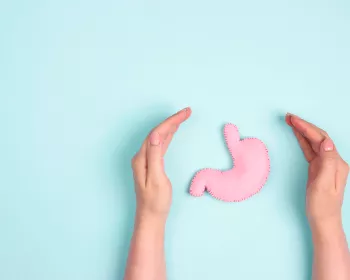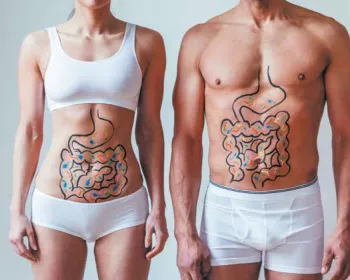Functional dyspepsia
Despite its strange-sounding name, functional dyspepsia is a common digestive disorder. Characteristic symptoms include stomach pain or heartburn, the feeling of an overfull stomach, discomfort, and nausea. Although not life-threatening, quality of life is affected by this disorder, in which the gut microbiota appears to be involved. Symptoms can be relieved by changing our diet or, potentially, by modifying the gut flora using probiotics.
- Learn all about microbiota
- Microbiota and related conditions
- Act on your microbiota
- Publications
- About the Institute
Healthcare professionals section
Find here your dedicated section
Sources
This article is based on scientific information
Sections
About this article

What is functional dyspepsia?
Symptoms and prevalence
Little known to the general public, functional dyspepsia (FD) is a very common gastrointestinal disorder that is under-diagnosed and still poorly understood today. FD accounts for 3% to 5% of GP visits in North America 1 !
The term dyspepsia comes from the Greek “dys” (poor) + “pepsis” (digestion).
Functional dyspepsia’s varied symptoms are always associated with a feeling of poor digestion 2:
- feeling full long before you’ve finished your meal
- the feeling of having eaten too much (stomach feels heavy and bloated), despite having eaten a perfectly reasonable-sized meal
- pain or burning in the upper stomach
- loss of appetite
- belching or hiccups
- nausea or even vomiting
Warning!
Symptoms must be long-lasting to qualify as functional dyspepsia: they must have been experienced for at least six months and present for at least three consecutive months.
There are two types offunctional dyspepsia:
- postprandial distress syndrome, characterized by the feeling of a bloated stomach (postprandial fullness) after a meal or by feeling full before the meal is over
- epigastric pain syndrome (concerning the upper and mid-abdomen area), where symptoms are not directly related to the meal (heartburn, etc.)
Did you know?
The disorder is called functional dyspepsia since it is not accompanied by any structural abnormality in the digestive organs and tissues. Symptoms cannot be explained by the presence of a lesion in the stomach (no ulcers) or any other organic or structural abnormality: all tests (gastroenteroscopy, ultrasound, CT scan, etc.) come out negative.
How common is the disease? Who is most at risk?
Studies suggest that 10% to 30% of adults and 3% to 27% of children worldwide are affected by functional dyspepsia 2. Women, smokers, and users of non-steroidal anti-inflammatory drugs (ibuprofen, ketoprofen) are at greater risk 3.
7% of adults are affected by functional dyspepsia ⁴
3% to 27% of children in the world are affected by functional dyspepsia ⁴
The consequences for patients are far from negligible: two-thirds of those affected by functional dyspepsia suffer from persistent and irregular symptoms that can affect their quality of life and well-being 1.

What factors are associated with functional dyspepsia?
Lifestyle, diet...
Diet
Increasingly clear is the role played by diet in triggering functional dyspepsia symptoms. The culprits? Above all, fatty foods. But they’re not alone. Carbohydrate-containing foods, milk and dairy products, citrus fruits, spicy foods, coffee, and alcohol, have also been implicated 5. However, the results of these studies remain uncertain.
Which foods are associated with which symptoms?
- Feeling too full after a meal: red meat, bananas, bread, wheat, cakes, pasta, sausages, fried foods, beans, mayonnaise, milk, chocolate, eggs, sweets, oranges and other citrus fruits
- Belching: soft drinks, onions, beans, milk, and bananas
- Burning in the upper stomach: coffee, cheese, onions, pepper, milk, chocolate, pineapple 5
The mind may also play a role, with the memory of a bad experience leading patients to anticipate symptoms and over-experience them when exposed again. Experience has shown that distracting a patient with a cognitive task is enough to make them forget about their symptoms. Conversely, stating that the fat content of a yogurt is higher than it actually is increases the nausea felt by patients
FODMAPs and dyspepsia
FODMAPs (fermentable oligosaccharides, disaccharides, monosaccharides, and polyols) are carbohydrates that humans have trouble digesting. They are thus fermented by gut bacteria (particularly Bifidobacteria), resulting in the production of gas and, therefore, bloating. Other potential effects include increased water volume in the digestive contents and excessive production of (sidenote: Short chain fatty acids (SCFA) Short chain fatty acids (SCFA) are a source of energy (fuel) for an individual’s cells. They interact with the immune system and are involved in communication between the intestine and the brain. Silva YP, Bernardi A, Frozza RL. The Role of Short-Chain Fatty Acids From Gut Microbiota in Gut-Brain Communication. Front Endocrinol (Lausanne). 2020;11:25. ) (propionate, butyrate, and acetate). Recent clinical trials suggest FODMAPs may be involved in the pathogenesis of functional dyspepsia 6.
Stress and anxiety
functional dyspepsia patients are often stressed and anxious: one large study showed that anxiety was clearly linked to the disease, and more specifically to postprandial distress; another study of 18,000 Japanese showed that patients with functional dyspepsia symptoms felt more stressed on a daily basis, more often mentioned not getting enough sleep, and complained more of difficulties in falling asleep 5.
Lack of physical activity
Functional dyspepsia patients generally report lower levels of physical activity. This is unfortunate since it appears that sport can actually reduce symptoms, and improve transit and gas evacuation in people suffering from bloating 5.
Microbiota & sport: competitive micro-organisms
Tobacco
A study of 2,560 Swedes shows that smokers are at greater risk of postprandial distress syndrome: smoking 10 to 19 cigarettes a day increases the risk by 42%, while smoking more than a pack a day more than doubles the risk 7.
Obesity
Obesity is associated with many gastrointestinal symptoms, including functional dyspepsia. Several hypotheses have been put forward: for example, in obese people, the oral and gut receptors responsible for alerting the body to the presence of fats may be altered, amplifying the gastrointestinal effects in these patients, making them more sensitive to dietary fats 5.
Some specialists also point to a reciprocal link between functional dyspepsia and (sidenote: Metabolic syndrome Metabolic syndrome, also known as syndrome X, is characterized by the accumulation of several metabolic disorders in the same individual, including a large waist circumference (due to excess abdominal adipose tissue), hypertension, abnormal fasting blood sugar levels or insulin resistance, and dyslipidemia. ) , with each promoting the other, creating a vicious circle 1.
Helicobacter pylori bacteria
Since the 1980s, it has been known that the stomach, although highly acidic, is not sterile. It even harbors a community of microorganisms, including the bacterium H. pylori. However, infection by H. pylori appears to lead to the onset and progression of functional dyspepsia: patients with a history of H. pylori infection have a higher risk of developing functional dyspepsia 2.

What role does the microbiota play?
Dysbiosis, the role of metabolites...
Dysbiosis throughout the digestive system
The digestive tract is home to almost 100 billion microorganisms from over 1,000 different species, which together are known as the gastrointestinal microbiota.
Proteobacteria, Firmicutes, Actinobacteria, and Bacteroidetes dominate this community, making up more than 98% of the gut microbiota, with Firmicutes predominating, followed by Actinobacteria and Bacteroidetes 2. At least in healthy patients. In those suffering from illnesses such as functional dyspepsia, this balance is not found; instead, dysbiosis is observed throughout the digestive system, from mouth to anus 2.
In functional dyspepsia patients, studies have found, for example:
- a higher abundance of Firmicutes, streptococcus (associated with symptoms in the upper stomach), Bifidobacterium and Clostridium
- a lower abundance of Prevotella (accompanied by more symptoms of discomfort after eating)
Have you heard of "dysbiosis"?
The role of microbial metabolites
The microbiota’s role in functional dyspepsia is far from limited to the bacteria present, since each of these bacteria secretes various active molecules, both beneficial and harmful, that are closely linked to host health and to the onset and progression of numerous diseases 2,3. For example:
- some bacterial metabolites have a beneficial effect (e.g. (sidenote: Short chain fatty acids (SCFA) Short chain fatty acids (SCFA) are a source of energy (fuel) for an individual’s cells. They interact with the immune system and are involved in communication between the intestine and the brain. Silva YP, Bernardi A, Frozza RL. The Role of Short-Chain Fatty Acids From Gut Microbiota in Gut-Brain Communication. Front Endocrinol (Lausanne). 2020;11:25. ) produced by Firmicutes)
- while others are harmful to the host (e.g. pro-inflammatory sphingolipids produced by Bacteroidetes and Prevotellacae) 3

What mechanisms are involved?
Immunity, the gut-brain axis...
While many gray areas remain, researchers believe that the mechanisms behind functional dyspepsia are likely to be multifactorial and vary from patient to patient 8. Thus, a range of mechanisms are involved in functional dyspepsia:
Disruption of the gut barrier
In normal circumstances, food passing through our digestive system remains isolated from our body by a barrier, the intestinal mucosa. This barrier is semi-permeable: it allows nutrients to be absorbed but bars passage to the various harmful substances and pathogens ingested along with our meal 2.
In functional dyspepsia patients, the integrity of this mucosa is compromised, so much so that it performs its filtering role less effectively
Disruption of gut immunity
In functional dyspepsia patients, there appears to be an excessive immune response: 40% of patients present inflammatory cells infiltrated into the duodenum, while a proliferation of bacteria (particularly oral bacteria) 9 is frequently observed in the small intestine, which may activate this immune response. Indeed, some researchers believe that a greater focus on the microbiota of the (sidenote: Small intestine Section of the digestive system between the stomach and the large intestine (i.e. the colon) essential for the digestion and absorption of nutrients. Measuring 21 to 23 feet, it is the longest portion of the digestive tract, comprising the duodenum, then the jejunum, and finally the ileum. ) is required in order to better understand the pathogenesis of functional dyspepsia 9.
A proliferation of bacteria in the small intestine (or small intestinal bacterial overgrowth – SIBO) may play a role in the pathogenesis of functional dyspepsia; indeed, this overgrowth appears to be more frequent in patients with functional dyspepsia than in those who do not suffer from the disorder 10,11. Among functional dyspepsia patients, those prescribed PPIs (proton pump inhibitors, drugs used to reduce gastric acid secretion) appear to be at greater risk of SIBO 12. By reducing stomach acidity, PPIs diminish the chemical barrier which is supposed to destroy a range of pathogenic micro-organisms using hydrochloric acid secreted by the stomach walls. This may explain the presence of excess bacteria in the small intestine, which lies just below the stomach.
However, evidence of a link between functional dyspepsia and SIBO remains tenuous: in the absence of easy access to duodenal flora, studies generally rely on the detection of gases in patients’ exhaled breath. This test is easy to perform and non-invasive but clearly lacks reliability 11.
Deregulation of the gut-brain axis
There are complex interactions between the gut microbiota, the digestive system, and the central nervous system. This microbiota-gut-brain axis explains why stress can cause stomach ache, or why changes in the gut flora can alter intestinal motility and “inform” the brain, which in turn can regulate the gut. However, functional dyspepsia has been shown to be closely linked to gastrointestinal motility disorders (which are under cerebral control) and to gastrointestinal hypersensitivity, all of which are linked to the gastrointestinal microbiota 2. From here to suggesting that everything is linked is only a short step...
What role does the microbiota play in the gut-brain axis?
An abnormal response to food ingestion
The presence of nutrients in the interior of the digestive tract produces signals that alter digestion. For example, a high-fat meal emains in the stomach longer, since gastric emptying is delayed. In functional dyspepsia patients, food ingestion may be associated with exaggerated signals from the gastrointestinal tract. This results in a whole series of symptoms which bear no relation to reality, such as feeling full when a meal has only just begun, hypersensitivity to gastric distension, and so on. 5

What are the existing and potential treatments for functional dyspepsia?
Diet, probiotics...
Diet
Logically, since diet is thought to play a role in functional dyspepsia, adapting it may improve symptoms. However, there is a dearth of studies highlighting the effects of specific diets. Nevertheless, experts believe that a large proportion of patients would benefit from a lower-fat diet and smaller meals eaten more often. In fact, functional dyspepsia patients are already doing so in practice: they have a slightly reduced dietary fat intake and tend to eat smaller meals more frequently 5.
Other patients would benefit more from avoiding spicy or acidic foods (tomatoes, citrus fruits, etc.) or foods rich in fiber or FODMAPs, which cause bloating. However, these restrictions should be managed with care so as to avoid an unbalanced diet 2.
Diet
Proton pump inhibitors
Proton pump inhibitors (PPIs) are drugs used to reduce gastric acid secretion. They are prescribed by doctors to treat gastroesophageal reflux disease (GERD) and peptic ulcers.
In the short term, proton pump inhibitors (PPIs) may improve functional dyspepsia symptoms. However, their long-term use seems to go hand in hand with an increase in Streptococcus and, thus, a harmful dysbiosis 13.
Antibiotics to eradicate H. pylori
According to the American College of Gastroenterology and the Canadian Association of Gastroenterology, functional dyspepsia patients under 60 years of age should first be screened for H. pylori. If the test proves positive, antibiotics should be prescribed to eradicate the bacteria.
However, this strategy has its limits: only 1 in 10 patients will experience an improvement in their symptoms, while the remainder will see their symptoms worsen 14.
Antibiotics: what impact on the microbiota and on our health?
Probiotics
Since dysbiosis of the gastrointestinal microbiota is closely linked to the onset and progression of functional dyspepsia, regulating the gastrointestinal microbiota has logically been put forward as a potential treatment 2. The role of probiotics may be multifactorial 15 :
- restoration of commensal flora eliminated by pathogens
- restoration of gut barrier permeability
- reduction of visceral hypersensitivity
- local and systemic anti-inflammatory action
- regulation of intestinal motility
All these benefits are thought to reduce symptoms of functional dyspepsia 15.
A large number of clinical studies seem to confirm “in practice” that probiotics can improve patients’ symptoms 2,15 .
However, the results published over the last 15 years are not sufficient to draw conclusions, since they have a number of shortcomings: the definition of the disease has continued to evolve; studies often confuse functional dyspepsia (long-lasting) with H. pylori infection (short-term); the probiotics used vary widely from one study to another; reports of symptoms remain unreliable due to a lack of clinical objectivity, and so on 15. Further research is still needed.
Alternative therapies
Various alternative therapies have been recognized as safe and effective treatments for functional dyspepsia:
- cognitive behavioral therapy, commonly used to treat stress and anxiety, helps the patient identify the thoughts or behaviors that lead to or exacerbate the expression of symptoms
- hypnotherapy, where the patient, in a state of hypnosis, is more receptive to therapeutic suggestions
- The potential of virtual reality is also being explored 14.




















